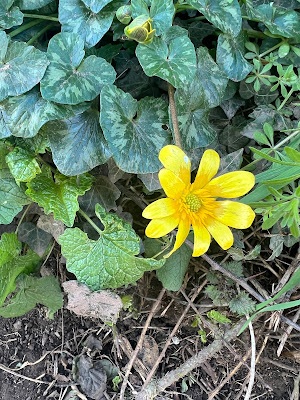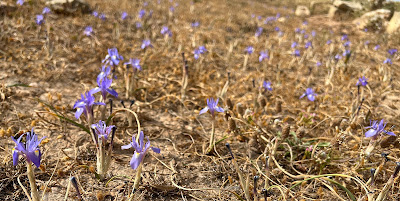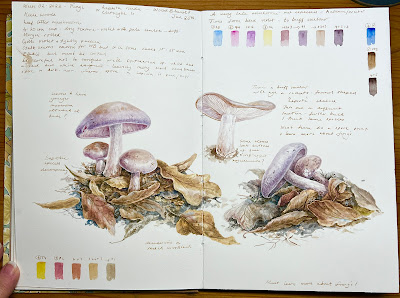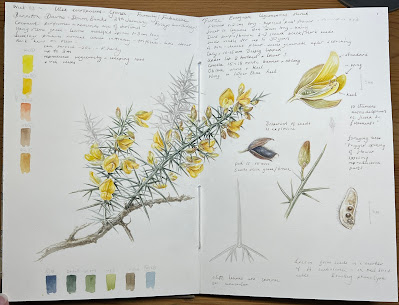Another year has passed and I've just completed the first of the 2022 sketchbook pages. This is a continuation of the same project as last year, 'Botanical Sketch Dates', which I've been doing with friend Debbie Crawford. My last post was up to week 38 of the book, there have been a few more entries since that time, so here they are.
 |
| First entry January 2022 Corylus avellana, Common Hazel |
The first for 2022 is
Corylus avellana, Hazel. The catkins were out by the first week of January so seemed the obvious choice. It's a monoecious native tree which means it has separate male and female flowers on the same plant, being self incompatible it needs pollen from a nearby tree for pollination and to bear fruit. Cross-pollination is the preferred strategy for most plants because it increases genetic diversity but many plants can self- pollinate if all else fails, Hazel isn't one of those plants.
The hazel nuts should be ready by July this year and I look forward to adding them. You can see that a rough sketch of the Lane where the trees are located is included, this is something I may start doing on a more regular basis and first tried it in the Yew tree entry below, which included the medieval crosses at St. Mary's Church, Checkley. By the way, if you click on the images in the post I think you open a clearer image than the ones embedded in the blog post.
 |
Week 40 December 1st 2021, Taxus baccata, English Yew at the Churchyard, Checkley, Staffs. Featuring three medieval crosses at the site.
|
With moving to a new year I did consider switching focus to garden plants, but in the end decided to stick with native, naturalised and some commonly found plants here in the UK. At the start of the project I had a broader scope but as the project developed, decided that native plants are my focus, they always have been really, and that's why I started painting plants all those years ago. With nearly 1400 native British plants and 1100 naturalised there are plenty to keep me busy.
My interest is in learning about plants and habitats, so I'm sticking with the natives and hope to travel to a few new locations to paint this year, coastal plants would make a good addition and I'm definitely going to pursue some of the many dandelion species, this was something I learned about last year - did you know there are over 240 species of dandelion! This doesn't mean I won't document the plants in the garden at a later date, they're certainly more colourful and easy access but I've hardly scratched the surface of our beautiful plant life to date!
If you read my previous post about sketchbooks and study pages, which included a video walk through of the book, you will know I also included fungi, this continued in November when I came across the wax caps at a local cemetery next to the Trentham Estate. The warm weather made it a good year for fungi, these little mushrooms are absolutely beautiful and very important too. The Parrot wax caps were found at Checkley graveyard the same week. I made a fun composition of them all together with some of the surrounding mosses and yew fruits, they seem to have an association with moss and I like to paint the substrate beneath - using a negative painting approach. Waxcaps are found in unimproved grasslands, but sadly I haven't seen them in too many other places, which says something about the state of our grasslands. The UK has lost 97% of its traditional meadow and grassland habitat and last year Plantlife ran a campaign with an app for people to look out for these beautiful little mushrooms, waxcaps are part of the species rich grasslands that are so important in carbon storage. Hopefully if Plantlife can find out about patches of remaining species rich grassland they can protect these areas.
 |
| Week 39 November 14th - 21st 2021 Waxcaps: Hygrocybe coccinea (scarlet wax cap), H. chlorophana (golden wax cap) and Gliophorus psittacinus |
Christmas week I painted that old favourite, Holly, Ilex aquifolium, which is of our very few native woody evergreen angiosperms. Holly is dioecious, which means it has separate male and female plants, so you will only find fruit on female trees. It has such a beautiful glossy dark leaves and they take a while to paint because colour should be built slowly, I made use of aerial perspective to make the task easier and to increase the depth of the whole branch. The spikes are tricky to paint as they point forwards and backwards, so good lighting is our best friend when painting holly! That said the spikiness varies, young leaves and those low down have more spikes, no doubt to protect from browsing, the top of the plant has more smooth edged leaves.
 |
| Week 41 December 23rd to 27th, 2021 Holly, Ilex aquifolium |
My final entry for 2021, was a simple dead oak leaf. I look out on the oak trees from my window everyday as I paint, so it seemed a fitting end to the year. It also prompted me to start a small book of leaf paintings in a concertina sketchbook ....yes another sketchbook project!
 |
| Week 42 on 31st December 202, a dried oak leaf, ready for the new year of plants and painting |
Finally, here are the first few entries in the little sketchbook of leaves. I promised a post about leaves a while back - haven't forgotten but still working on it....it's a big old topic.
 |
| A sketchbook of leaves for 2022 |
So that's all, I painted 51 species in 2021 over a 42 week period, it was great fun and I learned a lot about plants and painting.
Looking forward to completing some actual paintings this year too and developing the website with more new tutorials to share. Also thinking of doing a short presentation on some of the sketchpages so will keep you posted here.
Wishing you all a happy new year filled with plants and painting!













































